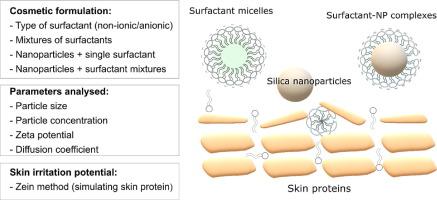Journal of Molecular Liquids ( IF 5.3 ) Pub Date : 2023-05-08 , DOI: 10.1016/j.molliq.2023.122021 Manuela Lechuga , Alejandro Avila-Sierra , Ismael Lobato-Guarnido , Ana I. García-López , Francisco Ríos , Mercedes Fernández-Serrano

|
There has been a notable upswing in the adoption of product formulations based on nanotechnology within the cosmetics industry. By using nanocarriers, such as solid or micellar nanoparticles, the quality and performance of cosmetics can be improved, allowing for better transport of bioactive components into the skin. However, it is important to note that the interaction between these compounds may lead to skin irritation. To mitigate skin irritability, nano-formulation strategies should be implemented in cosmetics. A proof-of-concept study was therefore conducted to investigate if low-toxicity nanoparticles (silica) could be used in combination with a mixture of anionic surfactants and a low-irritant cosurfactant (non-ionic) to develop safer cosmetic formulations that reduce skin damage. The skin irritation potential of the formulations was assessed in vitro using the well-known Zein method.
As anticipated, non-ionic surfactants pose the lowest risk for skin irritation. When compared to single anionic surfactants, non-ionic/anionic mixtures were found to decrease skin irritability by 24–67 %. However, when silica nanoparticles (NPs) were added to single surfactants, the potential for skin irritation increased, particularly when the anionic surfactant molecules were arranged in a spherical core-shell structure around the surface of the NPs. On the other hand, incorporating NPs in surfactant mixtures enhanced their formulation stability. While all three-component formulations were found to decrease skin irritability, those that formed spherical core-shell structures demonstrated the most significant reduction, likely related to a reduction in charge density caused by the non-ionic surfactant which may decrease protein solubilisation. Therefore, the inclusion of silica NPs can potentially result in a further reduction of the skin irritation potential caused by mixtures of anionic and non-ionic surfactants.
中文翻译:

通过掺入低毒性二氧化硅纳米粒子减轻阴离子和非离子表面活性剂混合物对皮肤的潜在刺激
化妆品行业采用基于纳米技术的产品配方的数量显着增加。通过使用纳米载体,如固体或胶束纳米颗粒,可以提高化妆品的质量和性能,从而更好地将生物活性成分输送到皮肤中。然而,重要的是要注意这些化合物之间的相互作用可能会导致皮肤刺激。为了减轻皮肤过敏,应在化妆品中实施纳米配方策略。因此进行了一项概念验证研究,以研究是否可以将低毒性纳米颗粒(二氧化硅)与阴离子表面活性剂和低刺激性辅助表面活性剂(非离子)的混合物结合使用,以开发更安全的化妆品配方,减少皮肤损害。在体外使用众所周知的玉米醇溶蛋白方法。
正如预期的那样,非离子表面活性剂对皮肤的刺激风险最低。与单一阴离子表面活性剂相比,发现非离子/阴离子混合物可将皮肤刺激性降低 24-67%。然而,当将二氧化硅纳米粒子 (NPs) 添加到单一表面活性剂中时,皮肤刺激的可能性增加,特别是当阴离子表面活性剂分子排列在 NPs 表面周围的球形核壳结构中时。另一方面,将 NP 掺入表面活性剂混合物中可提高其配方稳定性。虽然发现所有三组分配方都能降低皮肤刺激性,但那些形成球形核壳结构的配方表现出最显着的降低,这可能与非离子表面活性剂引起的电荷密度降低有关,这可能会降低蛋白质溶解。































 京公网安备 11010802027423号
京公网安备 11010802027423号